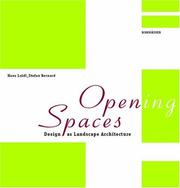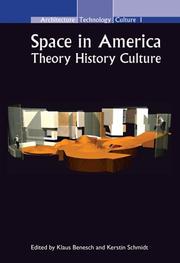| Listing 1 - 10 of 22 | << page >> |
Sort by
|

ISBN: 3038214876 3038218464 3038212237 9783038214878 9783038214854 9783038212232 3764370130 9783764370138 9783038218463 Year: 2014 Publisher: Basel
Abstract | Keywords | Export | Availability | Bookmark
 Loading...
Loading...Choose an application
- Reference Manager
- EndNote
- RefWorks (Direct export to RefWorks)
"What does the landscape architect actually do as a design?" The authors investigate this seemingly simple question. What resources are available for designing open spaces? What part is played by conditions deriving from nature? How are locations and spaces created in the open air, how are paths routed and boundaries set, how are hard and soft materials used? Drawing on practical and theoretical experience, this introduction, often used as a textbook, reveals the central components of design and the intellectual paths followed in the design process."The book is not so much for reading but for doing. It plays with shapes, imagining how people feel in these shapes and seeing how shapes create a different experience of landscape. Vegetation can make the relief of a hill clearer, less clear, indistinct or hidden. The authors show this by sketches illustrating the text ... As an example of the way Loidl and Bernard set their readers thinking for themselves, I "e what they regard as good design: 'The paradox of a good design solution: more uniformity needs more variety.'Food for thought. Or read Open(ing) Spaces." (Martin Woestenburg in 'scape, 2006)
Architecture --- Landscape architecture. --- Architectural designs --- Designs, Architectural --- 712.25 --- 712.25 Planologie van openbare groenvoorzieningen: parken; plantsoenen --- Planologie van openbare groenvoorzieningen: parken; plantsoenen --- Horticultural service industry --- Landscape gardening --- Landscaping industry --- Architectural drawing --- 712.3 --- 712.2 --- 712.3 Tuinarchitectuur. Tuinaanleg --- Tuinarchitectuur. Tuinaanleg --- 712.2 Planologie van landschappen--(algemeen) --- Planologie van landschappen--(algemeen) --- Architecture du paysage --- Espace (architecture) --- Space (Architecture) --- Espace (Architecture) --- Architecture du paysage.

ISBN: 0415301580 0415301599 020368365X 1134417527 1280037121 0203643763 9780203643761 9780415301589 9780415301596 9786610037124 6610037124 9781134417476 9781134417513 9781134417520 1134417519 Year: 2004 Publisher: London New York Routledge
Abstract | Keywords | Export | Availability | Bookmark
 Loading...
Loading...Choose an application
- Reference Manager
- EndNote
- RefWorks (Direct export to RefWorks)
This book investigates the perception and appropriation of places across intervals of time and culture. The particular concern of the volume is to bring together fresh empirical research and animate it with theoretical sophistication,.
Architecture and history. --- Space (Architecture) --- Architecture et histoire --- Espace (Architecture) --- Space (Architecture). --- Architecture. --- Art, Architecture & Applied Arts --- Architecture --- Architecture and space --- Space and architectural mass --- Space in architecture --- History and architecture --- City planning --- History --- Composition, proportion, etc. --- Negative space (Architecture)
Book
ISBN: 3035618003 3035618054 9783035618006 9783035618051 9783035617986 3035617988 Year: 2019 Publisher: Basel
Abstract | Keywords | Export | Availability | Bookmark
 Loading...
Loading...Choose an application
- Reference Manager
- EndNote
- RefWorks (Direct export to RefWorks)
Architecture creates complex spatial situations that are the subject of urban design. Design uses a repertoire of specific architectural means in a creative way, resulting in cities that can be lived in and perceived in their three-dimensional experience. The current book, an extended new edition of Architecture of the City (2016), describes the repertoire with which architecture and design regain an entry to urbanistics. It pleads for an "architectonic turn" in urbanistics - a demand to finally comprehend the city architecturally: the issue is not just about buildings in the city, but about architecture of the city as a whole, as is clearly expressed in the new title of City as Architecture. Architektur ist die Kunst, Räume zu artikulieren. Auch für den Maßstab der Stadt, von der Türschwelle bis zur Region, geht es um die Architektur urbaner Räume. Diese sind Gegenstand des architektonischen Entwurfs, der ein Repertoire spezifischer Mittel schöpferisch einsetzt, so dass wir Städte als räumlich gestaltet erleben. Dieses architektonische Repertoire wird hier beschrieben. Entwurf und urban design finden wieder Eingang in die Urbanistik.
Space (Architecture) --- Architecture and space --- Space and architectural mass --- Space in architecture --- Architecture --- City planning --- Composition, proportion, etc. --- Negative space (Architecture) --- City planning. --- Espace (architecture) --- Urbanisme --- Composition (architecture) --- Philosophie
Book
ISBN: 9781474271387 9781474271400 9781474271394 1474271383 9781350095908 1350095907 1474271391 1474271405 Year: 2018 Publisher: London Bloomsbury Methuen Drama, an imprint of Bloomsbury Publishing Plc
Abstract | Keywords | Export | Availability | Bookmark
 Loading...
Loading...Choose an application
- Reference Manager
- EndNote
- RefWorks (Direct export to RefWorks)
The Model as Performance investigates the history and development of the scale model from the Renaissance to the present from a scenographic perspective and a performative paradigm that explores what the model can do and how it is used in theatre and architecture. It provides a comprehensive historical context and theoretical framework for theatre scholars, scenographers, artists and architects interested in the model's reality-producing capacity and its recent emergence in contemporary art practice and exhibition. For the undergraduate student, it provides a historical survey of the model, and to the postgraduate student, it opens up a new methodological approach. Introducing a typology of the scale model beyond the iterative and the representative model, the authors identify the autonomous model as a provocative construction between past and present, idea and reality that challenges and redefines the relationship between object, viewer and environment. Case studies include Brunelleschi's dome models and Bel Geddes' Futurama, Mies van der Rohe's mock ups and Zumthor's atmospheric models, Anna Viebrock's life size boxes and Herzog & de Meuron's miniature styrofoam exhibits.
Architectural models. --- Space (Architecture). --- Theater architecture. --- Theaters --- Models. --- Stage-setting and scenery. --- Espace (architecture) --- Théâtres --- Modèles --- Histoire --- scenography [discipline] --- space [composition concept] --- Stage design. Scenography --- Public buildings --- architectural models --- Histoire. --- Space (Architecture) --- Models --- History. --- Architectural models --- Espace (Architecture) --- Modèles architecturaux --- Théâtres (Édifices) --- Espace (Théâtre) --- Stage-setting and scenery --- 725.82 --- Opera-houses --- Playhouses (Theaters) --- Theatres --- Arts facilities --- Auditoriums --- Centers for the performing arts --- Music-halls --- Architecture and space --- Space and architectural mass --- Space in architecture --- Architecture --- City planning --- 725.82 Gebouwen met nadruk op het visuele aspect --- Gebouwen met nadruk op het visuele aspect --- Models&delete& --- History --- Composition, proportion, etc. --- Negative space (Architecture) --- Théâtres --- Modèles --- Theatre studies
Book
ISBN: 9783990435632 3990435639 3990435760 9783990435762 Year: 2013 Publisher: Basel/Berlin/Boston
Abstract | Keywords | Export | Availability | Bookmark
 Loading...
Loading...Choose an application
- Reference Manager
- EndNote
- RefWorks (Direct export to RefWorks)
As the subject of earnest discussion, the meaning of space reaches far beyond the horizon of a single discipline. Lukas Feiriss has assembled a collection of international contributions for Space Matters, a publication of the space & design strategies study program of the University of Art and Design, Linz, Austria to create an inspiring expansion of the contemporary discourse on space. The publication addresses cultural researchers and readers in creative professions - architects, artists, curators, scientists and students in all the related fields as well as those members of a broader audience that are interested in the incorporation of space and the practices with which it is designed in cultural, social and humanities-oriented contexts. Raum eröffnet als Gegenstand ernsthafter Diskussion einen Bedeutungshorizont, der weit über die Grenzen einer einzelnen Disziplin hinausreicht. Vor diesem Hintergrund versammelt das von Lukas Feireiss für den Studiengang raum&designstrategien der Kunstuniversität Linz herausgegebene Buch Space Matters internationale Beiträge, welche eine inspirierende Erweiterung der zeitgenössischen Auseinandersetzung mit Raum markieren. Die Publikation richtet sich an Kulturwissenschaftler und Kulturschaffende - Architekten, Künstler, Kuratoren, Wissenschaftler und Studierende aller verwandten Fächer sowie an eine breite Öffentlichkeit, die sich für die Einbeziehung zeitgenössischer raumschaffender Praktiken in kultur-, sozial- und geisteswissenschaftliche Kontexte interessieren.
Space (Architecture) --- Architecture, Modern --- City planning. --- Espace (Architecture) --- Architecture --- Urbanisme --- History --- Histoire --- 72.017 --- 373.67 --- 72.01 --- Ruimte (architectuur) --- Architectuuronderzoek --- Onderzoek (architectuur) --- Onderwijs (architectuur) --- Architectuuronderwijs --- Architectuurtheorie --- Architectuur (theorie) --- Architecture and space --- Negative space (Architecture) --- Space and architectural mass --- Space in architecture --- City planning --- Composition, proportion, etc.
Periodical
ISSN: 21952701 Year: 2014
Abstract | Keywords | Export | Availability | Bookmark
 Loading...
Loading...Choose an application
- Reference Manager
- EndNote
- RefWorks (Direct export to RefWorks)
"With its focus on the pluralism of positions and project perspectives regarding the city, territory and architecture, this journal aims to open up an interdisciplinary debate on the relational nature of projects for spaces where people settle and interrelate. The City, Territory and Architecture journal (CTA) is dedicated to sharing scientific (theoretical and applied) knowledge and positions on spaces of city and territory. Its primary goal is to explore the conceptual and physical relations between city, territory and architecture."
City planning --- Space (Architecture) --- Urbanisme --- Espace (Architecture) --- Periodicals --- Périodiques --- City planning. --- Architecture and space --- Space and architectural mass --- Space in architecture --- Cities and towns --- Civic planning --- Land use, Urban --- Model cities --- Redevelopment, Urban --- Slum clearance --- Town planning --- Urban design --- Urban development --- Urban planning --- Planning --- Government policy --- Management --- landscape planning --- regional planning --- urban planning --- urban ecology --- landscape ecology --- Architecture --- Land use --- Art, Municipal --- Civic improvement --- Regional planning --- Urban policy --- Urban renewal --- Composition, proportion, etc. --- Negative space (Architecture) --- Sociology of environment

ISBN: 9042018763 9401202397 1423785940 9781423785941 9789042018761 9789401202398 9789042018761 Year: 2005 Publisher: Amsterdam New York, NY Rodopi
Abstract | Keywords | Export | Availability | Bookmark
 Loading...
Loading...Choose an application
- Reference Manager
- EndNote
- RefWorks (Direct export to RefWorks)
America's sense of space has always been tied to what Hayden White called the narrativization of real events. If the awe-inspiring manifestations of nature in America (Niagara Falls, Virginia's Natural Bridge, the Grand Canyon, etc.) were often used as a foil for projecting utopian visions and idealizations of the nation's exceptional place among the nations of the world, the rapid technological progress and its concomitant appropriation of natural spaces served equally well, as David Nye argues, to promote the dominant cultural idiom of exploration and conquest. From the beginning, American attitudes towards space were thus utterly contradictory if not paradoxical; a paradox that scholars tried to capture in such hybrid concepts as the middle landscape (Leo Marx), an engineered New Earth (Cecelia Tichi), or the technological sublime (David Nye). Not only was America's concept of space paradoxical, it has always also been a contested terrain, a site of continuous social and cultural conflict. Many foundational issues in American history (the dislocation of Native and African Americans, the geo-political implications of nation-building, immigration and transmigration, the increasing division and clustering of contemporary American society, etc.) involve differing ideals and notions of space. Quite literally, space and its various ideological appropriations formed the arena where America's search for identity (national, political, cultural) has been staged. If American democracy, as Frederick Jackson Turner claimed, is born of free land, then its history may well be defined as the history of the fierce struggles to gain and maintain power over both the geographical, social and political spaces of America and its concomitant narratives. The number and range of topics, interests, and critical approaches of the essays gathered here open up exciting new avenues of inquiry into the tangled, contentious relations of space in America. Topics include: Theories of Space - Landscape / Nature - Technoscape / Architecture / Urban Utopia - Literature - Performance / Film / Visual Arts.
Arts, Modern --- Space (Architecture) --- Space and time. --- Space of more than three dimensions --- Space-time --- Space-time continuum --- Space-times --- Spacetime --- Time and space --- Fourth dimension --- Infinite --- Metaphysics --- Philosophy --- Space sciences --- Time --- Beginning --- Hyperspace --- Relativity (Physics) --- Architecture and space --- Negative space (Architecture) --- Space and architectural mass --- Space in architecture --- Architecture --- City planning --- Modern arts --- Themes, motives. --- Composition, proportion, etc. --- ESPACE --- ESPACE (ARCHITECTURE) --- PERCEPTION --- HISTOIRE --- ETATS-UNIS
Book
ISBN: 9781107040496 1107040493 9781139629041 1316464024 1316465586 1316464415 1316466361 1139629042 131646363X 1316461297 9781316466360 Year: 2016 Publisher: Cambridge Cambridge University Press
Abstract | Keywords | Export | Availability | Bookmark
 Loading...
Loading...Choose an application
- Reference Manager
- EndNote
- RefWorks (Direct export to RefWorks)
Taking public space as her starting point, Amy Russell offers a fresh analysis of the ever-fluid public/private divide in Republican Rome. Built on the 'spatial turn' in Roman studies and incorporating textual and archaeological evidence, this book uncovers a rich variety of urban spaces. No space in Rome was solely or fully public. Some spaces were public but also political, sacred, or foreign; many apparently public spaces were saturated by the private, leaving grey areas and room for manipulation. Women, slaves, and non-citizens were broadly excluded from politics: how did they experience and help to shape its spaces? How did the building projects of Republican dynasts relate to the communal realm? From the Forum to the victory temples of the Campus Martius, culminating in Pompey's great theatre-portico-temple-garden-house complex, The Politics of Public Space in Republican Rome explores how space was marked, experienced, and defined by multiple actors and audiences.
Public spaces --- Space (Architecture) --- City and town life --- History. --- Social aspects --- Rome --- Rome (Italy) --- Social life and customs. --- Antiquities. --- History --- Espaces publics --- Espace (Architecture) --- Vie urbaine --- Aspect social --- Rome (Italie) --- Moeurs et coutumes --- Antiquités --- Histoire --- Social aspects. --- Architecture and space --- Negative space (Architecture) --- Space and architectural mass --- Space in architecture --- Architecture --- City planning --- Public places --- Social areas --- Urban public spaces --- Urban spaces --- Cities and towns --- City life --- Town life --- Urban life --- Sociology, Urban --- Composition, proportion, etc.
Periodical
Abstract | Keywords | Export | Availability | Bookmark
 Loading...
Loading...Choose an application
- Reference Manager
- EndNote
- RefWorks (Direct export to RefWorks)
Space frame structures --- Space (Architecture) --- Structural frames --- Space frame structures. --- Structural frames. --- Framed structures --- Frames (Structures) --- Frames, Structural --- Frameworks (Structures) --- Structural analysis (Engineering) --- Structural design --- Structural engineering --- Space structures --- Structures, Space frame --- Architecture --- Building --- Architecture and space --- Space and architectural mass --- Space in architecture --- City planning --- Composition, proportion, etc. --- Raumtragwerk. --- Raumtragwerk --- Räumliches Tragwerk --- Space frame structure --- Tragwerk --- Negative space (Architecture) --- Structures spatiales --- Espace (Architecture)
Book
ISBN: 9789004355606 9789004355620 9004355626 900435560X Year: 2018 Publisher: Leiden Boston
Abstract | Keywords | Export | Availability | Bookmark
 Loading...
Loading...Choose an application
- Reference Manager
- EndNote
- RefWorks (Direct export to RefWorks)
Architecture and Control' makes a collective critical intervention into the relationship between architecture, including virtual architectures, and practices of control since the turn of the twentieth to twenty-first centuries. Authors from the fields of architectural theory, literature, film and cultural studies come together here with visual artists to explore the contested sites at which, in the present day, attempts at gaining control give rise to architectures of control as well as the potential for architectures of resistance. Together, these contributions make clear how a variety of post-2000 architectures enable control to be established, all the while observing how certain architectures and infrastructures allow for alternative, progressive modes of control, and even modes of the unforeseen and the uncontrolled, to arise.
Architecture et politique. --- Architecture --- Architecture et technologie. --- Espace (architecture) --- Contrôle (psychologie) --- Space (Architecture) --- Control (Psychology) --- Architecture and society --- Aspect social. --- Aspect psychologique. --- Psychological aspects --- Psychological aspects. --- Architecture and society. --- Architecture and sociology --- Society and architecture --- Sociology and architecture --- Power (Psychology) --- Emotions --- Psychology --- Senses and sensation --- Architecture and space --- Negative space (Architecture) --- Space and architectural mass --- Space in architecture --- City planning --- Social aspects --- Human factors --- Composition, proportion, etc. --- Contrôle (psychologie)
| Listing 1 - 10 of 22 | << page >> |
Sort by
|

 Search
Search Feedback
Feedback About UniCat
About UniCat  Help
Help News
News